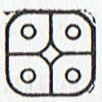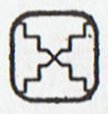|
TRANSLATIONS
A few additions: The sign with a quincunx pattern in the glyph for the 3rd location is Gates' number 311:
Says he: "... The Madrid chapter extending from page 89 to 102, deals with various cult ceremonies; the pages where this glyph [311] is frequent are in part devoted to the growing and flowering of corn, and then pass into sections on the carving of the images, as referred to by Landa in the month Mol ..." The 3rd location may very well refer to agricultural work. Working with images in Mol reminds us of the kavakava images. The quick succession from growing to flowering of corn goes equally quick on to next stage, its desiccation, I think. The dead wood is used not only for fires in the evening but also for carving images. Gates says at his 69 ('yellow', kan): "This sign must first be definitely separated from ... [311] ... the glyph with five small circles within, distinct from the corner positions shown here. In this present form it is proven to equal yellow, by its use in series. But we also get it in more than one place where it can hardly be separated from being a mere kin-variant ... ... Brightness and the color yellow are closely allied, in natural facts; the sun is both golden and bright. By a wholly normal linguistic development, the sign for yellow might have come to be applied to and define a Season, just as we associate yellow and purple with Spring and Easter."
Yaxkin is though the opposite of yaxkan - equally different as yin and yang. I have added the day sign 7 Lamat as a 3rd member in the quincunx group. I imagine 7 Lamat could signify how the soul of the dead is rising up to the sky to become a star (i.e. a fire). The quincunx pattern has a fire in its center, we know. The kan (yellow, sun) sign presumably shows the 4 cardinal directions in the corners, the 'white old legs' (bacabs) holding the sky roof high. 311 is the same yet different. It could be a picture of how land on earth is measured out and marked by pillars (stones instead of stars). In the center of such an imporant field a sacred hearth must be (I imagine). Next triplet of stations:
This is most curious. The holy tree (ceiba), is at left and the sea (naab) at right, and in the middle is earth (caban),
the 8-fold sign protecting the back of the Rain God - suddenly we are in the sky:
Maybe the scene has shifted from the 1st quarter (the 1st half of earth) to something happening in the sky at midsummer? Maybe the Rain God has climbed to the top of the tree and then fallen down (Ollin, movement), not only to earth but down into a hole in the earth. From one pole to its opposite. Maybe down into a well (Ch'en) filled with water from the sea (naab)? Possibly Etz'nab alludes to naab. The glyph has kava-like lines crossing from one corner to its opposite:
These crossing lines are no waves of the sea. The smooth curves of Caban have here been transformed into their opposites - straight lines trying there best to follow the waves. The flint knife is male, the earth is female. Movement (Ollin) means life, while a knife means death. We expect a house to be erected at midsummer. The tree is part of the solution for that. What happens though is that a house has been built under ground. The Maya had a convention for how 'houses' should be depicted:
"... Itzamná sits within a house, whose pillar is bound by the crossed bands ..." (Gates) When the sun god is 'inside' he is barred, I think. He is sitting on 'grapes' to a number of 10, his time has run out, therefore he is inside. When time reaches midsummer it reaches midwinter on the other side of the equator. A new light must be arranged for them. Therefore - I imagine - our sun must abruptly leave at midsummer, go to work lighting the new fire at the other pole. It is the same pole of course, only the other end of it, of the great tree (Milky Way). Therefore he is not climbing the tree in the picture of the 4th location, he is quickly shooting - like a star - down to its other end, there to perform the Marduk task of 'cleaving' the night; there is a kan sign in the 1st month:
Then sun returns again - there are 'barred' signs in Uo an Zip. In Pop the sign is different. Right in a Mayan glyph means in its beginning. The designer has 'joked', combined the 'barred' sign with an allusion to weaveing. Here we get the explanation of why Anakena the sunny beach of northern summer has given its name to the month Anakena, the darkest part of the year. In the kuhane map it it the time of Piringa Aniva, when all the people gather to give feathers to the king, helping him igniting the new fire. The king leaves his sunny beach for the other pole end of this island to receive them. From the end of the 1st half of summer (locations 1-3) we have made a time travel to midwinter. The 'cauac'-months carry 6 'grapes' each, together 24 such:
Probably it means sun still is ruling, although the top sign in Ch'en illustrates the vacancy in that month. It is a sign not far from that of the sign of wind - not visible. It is like the result of 'clearing away' when a great season has ended. With Ch'en a new season begins, 80 days long according to the Mayan calendar. Then comes the great 'slaughter':
Possibly the difference between the suggested twice 96 and twice 84 for the number of summer days and winter days on Easter Island owns its origin from these '6-grape' shapes in Cauac. Summer has borrowed these 'grapes' from winter. Maybe Moan is a vulture rather than an owl:
|
|||||||||||||||||||||||||||||||||||||||||||||||||||||||||||||||||||||||||||||||||||||||||||||||||||||||||||||||||||||||























